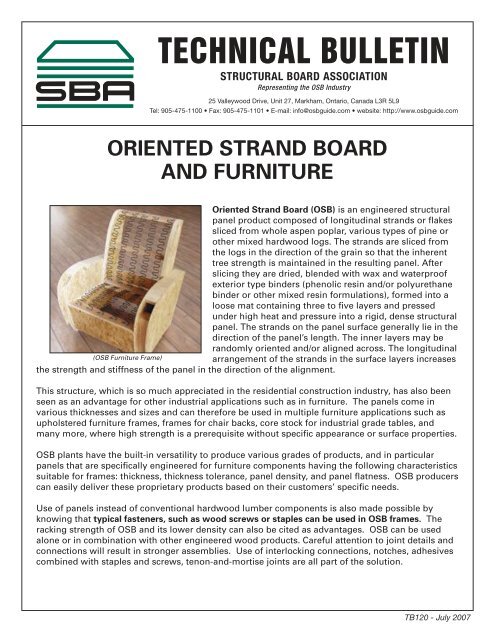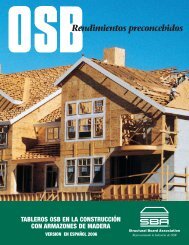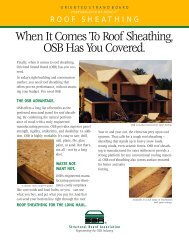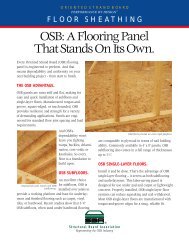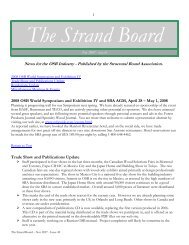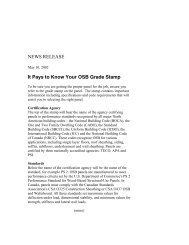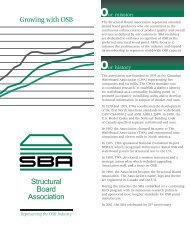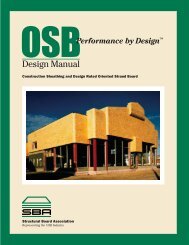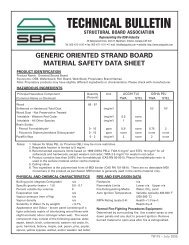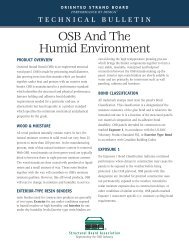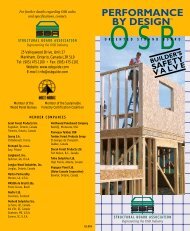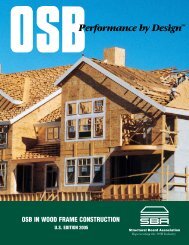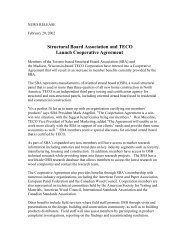OSB and Furniture (TB120) - OSBGuide - TECO
OSB and Furniture (TB120) - OSBGuide - TECO
OSB and Furniture (TB120) - OSBGuide - TECO
Create successful ePaper yourself
Turn your PDF publications into a flip-book with our unique Google optimized e-Paper software.
TECHNICAL BULLETIN<br />
STRUCTURAL BOARD ASSOCIATION<br />
Representing the <strong>OSB</strong> Industry<br />
25 Valleywood Drive, Unit 27, Markham, Ontario, Canada L3R 5L9<br />
Tel: 905-475-1100 • Fax: 905-475-1101 • E-mail: info@osbguide.com • website: http://www.osbguide.com<br />
ORIENTED STRAND BOARD<br />
AND FURNITURE<br />
Oriented Str<strong>and</strong> Board (<strong>OSB</strong>) is an engineered structural<br />
panel product composed of longitudinal str<strong>and</strong>s or flakes<br />
sliced from whole aspen poplar, various types of pine or<br />
other mixed hardwood logs. The str<strong>and</strong>s are sliced from<br />
the logs in the direction of the grain so that the inherent<br />
tree strength is maintained in the resulting panel. After<br />
slicing they are dried, blended with wax <strong>and</strong> waterproof<br />
exterior type binders (phenolic resin <strong>and</strong>/or polyurethane<br />
binder or other mixed resin formulations), formed into a<br />
loose mat containing three to five layers <strong>and</strong> pressed<br />
under high heat <strong>and</strong> pressure into a rigid, dense structural<br />
panel. The str<strong>and</strong>s on the panel surface generally lie in the<br />
direction of the panel’s length. The inner layers may be<br />
r<strong>and</strong>omly oriented <strong>and</strong>/or aligned across. The longitudinal<br />
(<strong>OSB</strong> <strong>Furniture</strong> Frame)<br />
arrangement of the str<strong>and</strong>s in the surface layers increases<br />
the strength <strong>and</strong> stiffness of the panel in the direction of the alignment.<br />
This structure, which is so much appreciated in the residential construction industry, has also been<br />
seen as an advantage for other industrial applications such as in furniture. The panels come in<br />
various thicknesses <strong>and</strong> sizes <strong>and</strong> can therefore be used in multiple furniture applications such as<br />
upholstered furniture frames, frames for chair backs, core stock for industrial grade tables, <strong>and</strong><br />
many more, where high strength is a prerequisite without specific appearance or surface properties.<br />
<strong>OSB</strong> plants have the built-in versatility to produce various grades of products, <strong>and</strong> in particular<br />
panels that are specifically engineered for furniture components having the following characteristics<br />
suitable for frames: thickness, thickness tolerance, panel density, <strong>and</strong> panel flatness. <strong>OSB</strong> producers<br />
can easily deliver these proprietary products based on their customers’ specific needs.<br />
Use of panels instead of conventional hardwood lumber components is also made possible by<br />
knowing that typical fasteners, such as wood screws or staples can be used in <strong>OSB</strong> frames. The<br />
racking strength of <strong>OSB</strong> <strong>and</strong> its lower density can also be cited as advantages. <strong>OSB</strong> can be used<br />
alone or in combination with other engineered wood products. Careful attention to joint details <strong>and</strong><br />
connections will result in stronger assemblies. Use of interlocking connections, notches, adhesives<br />
combined with staples <strong>and</strong> screws, tenon-<strong>and</strong>-mortise joints are all part of the solution.<br />
<strong>TB120</strong> - July 2007
Properties that are thought to be relevant to furniture frame use are density, internal bond, surface<br />
soundness, impact strength, screw <strong>and</strong> staple holding, <strong>and</strong> grit content. One of the key considerations<br />
for a furniture manufacturer is the fastener holding capabilities of the material. Several studies<br />
have shown equivalent performance in that respect when compared to plywood or MDF, <strong>and</strong><br />
generally better performance than for particleboard. Table 1 lists some minimum requirements in<br />
US or Canadian specifications for wood panels <strong>and</strong> Table 2 summarizes past studies conducted on<br />
some fastener properties.<br />
When compared to particleboard <strong>and</strong> MDF during a project at the Université Laval <strong>and</strong> Forintek,<br />
the average unit screw <strong>and</strong> staple head-pull through of <strong>OSB</strong> was found to be very similar for equal<br />
panel thicknesses. The report also pointed to reducing panel density variability in the plane of the<br />
panel <strong>and</strong> across the thickness to improve fastener-holding capacity in <strong>OSB</strong> panels produced for the<br />
furniture industry (1).<br />
Research at the University of Illinois (2) concluded, “In both the nail <strong>and</strong> staple direct withdrawal<br />
tests, <strong>OSB</strong> performed equal to or better than CD-grade plywood sheathing in all exposures tested.<br />
The nail-head pull-through <strong>and</strong> staple-crown pull-through tests yielded similar average values in all<br />
wood-based panels in all exposures. The average values for nail <strong>and</strong> staple withdrawal <strong>and</strong> pullthrough<br />
resistance of most of the nine wood-based materials tested met the minimum requirements<br />
of various specifications or st<strong>and</strong>ards.”<br />
Another Forintek report (3) stated “Structural panels (<strong>OSB</strong> <strong>and</strong> plywood) offer potential cost savings<br />
to furniture manufacturers in terms of material costs <strong>and</strong> manufacturing efficiency. Panel recovery<br />
factors for operations using a computer numeric control (CNC) router with optimised cutting<br />
pattern can range from 85% to 90% compared with 70% <strong>and</strong> lower for hardwood lumber. Additional<br />
cost savings from using panels can come from increased automation, reduced h<strong>and</strong>ling, fewer<br />
processing operations <strong>and</strong> st<strong>and</strong>ardization of parts or components. Although edge staple holding<br />
was initially a problem for <strong>OSB</strong> when compared with hardwood, minor design changes resulted in<br />
increased strength <strong>and</strong> stiffness for the <strong>OSB</strong> arm assembly.”<br />
Findings from another Forintek study (4) pointed out the “possibility to combine the material cost<br />
of <strong>OSB</strong> panels with the structural performance <strong>and</strong> manufacturing efficiency advantages of metal<br />
plate connectors to achieve substantial<br />
cost savings in the manufacture of upholstered<br />
furniture frames. The study found<br />
that the bending capacity of <strong>OSB</strong> assemblies<br />
connected with metal connector<br />
plates was affected by joint configuration,<br />
type of loading <strong>and</strong> plate area. Assemblies<br />
with two pairs of plates were approximately<br />
50% stronger <strong>and</strong> stiffer than<br />
assemblies made with one pair of plates<br />
of the same area. Results also showed<br />
that static-to-fatigue ratios of moment<br />
capacity of test assemblies averaged<br />
2.5, meaning that it is advised to design<br />
metal-plated joints so that they will not<br />
be loaded to more than 40% of their static<br />
moment capacity. “<br />
(Test assembly for <strong>OSB</strong> frame joints.)<br />
2 <strong>TB120</strong>
(1) Xiaodong Wang et al., Université Laval, Forest Products Journal 57(1/2):103-109, Localized<br />
density effects on fastener holding capacities in wood-based panels.<br />
(2) Poo Chow et al., University of Illinois-Urbana, Forest Products Journal 38(6):19-25, Direct<br />
withdrawal <strong>and</strong> head pull-through performance of nails <strong>and</strong> staples in structural woodbased<br />
panel materials.<br />
(3) Robert M Knudson, Forintek Canada Corp (2005), Project # 4535, <strong>OSB</strong> use in furniture<br />
manufacturing.<br />
(4) Mohammad Mohammad et al, Forintek Canada Corp, for Alberta Forestry Research<br />
Institute (Report # 851G-07), Fastening Systems to Improve Performance of <strong>Furniture</strong><br />
Frames Built from <strong>OSB</strong>.<br />
<br />
Table 1 – Minimum Requirements – Pounds (Newtons)<br />
Specification<br />
or St<strong>and</strong>ard<br />
Fastener<br />
Type<br />
Lateral Resistance<br />
Withdrawal<br />
Dry Wet/Dry Face Edge<br />
NIST PS 2<br />
(<strong>OSB</strong>/ PLY)<br />
Nail<br />
Varies by<br />
grade from<br />
120 to 210<br />
(534 to 934)<br />
Varies by<br />
grade from<br />
90 to 160<br />
(434 to 712)<br />
CSA O437<br />
(<strong>OSB</strong>)<br />
Nail<br />
400t (70t),<br />
t = thickness<br />
ANSI A208.2<br />
(MDF)<br />
Screw<br />
Varies by<br />
grade from<br />
175 to 350<br />
(778 to 1557)<br />
Varies by<br />
grade from<br />
150 to 300<br />
(670 to 1335)<br />
ANSI A208.1<br />
(PB)<br />
Screw<br />
Varies by<br />
grade from<br />
202 to 450<br />
(900 to 2000)<br />
Varied by<br />
grade from<br />
180 to 348<br />
(800 to 1550)<br />
(Note: Details about these requirements can be obtained from the SBA.)<br />
3
Table 2 – Various Fastener Test Results in <strong>OSB</strong><br />
Property Evaluated By Whom How <strong>OSB</strong> Thickness,<br />
in. (mm)<br />
Average Results<br />
Dry, lbs (N)<br />
Average Results<br />
Cyclic, lbs (N)<br />
Nail - Withdrawal<br />
Nail - Head Pull-through<br />
Nail - Lateral Resistance<br />
<strong>TECO</strong> (USA) ASTM D1037<br />
(10d nail)<br />
5/8” <strong>and</strong> 3/4”<br />
(15 mm <strong>and</strong><br />
18 mm)<br />
96 (427)<br />
576 (2562)<br />
646 (2873) 448 (1993)<br />
Screw Withdrawal - Face<br />
Screw Withdrawal - Edge<br />
<strong>TECO</strong> (USA) ASTM D1037–<br />
Type 10 sheet<br />
metal screw<br />
5/8” <strong>and</strong> 3/4”<br />
(15 mm <strong>and</strong><br />
18mm)<br />
304 (1352)<br />
267 (1188)<br />
N/A<br />
Screw holding – Face<br />
Screw holding – Edge<br />
Staple holding – Edge<br />
Staple - Head pull-through<br />
<strong>Furniture</strong><br />
Industries<br />
Research<br />
Association (UK)<br />
Custom test 7/16” (11 mm) 200 (890)<br />
172 (765)<br />
188 (836)<br />
140 (623)<br />
N/A<br />
Staple - Withdrawal – Edge<br />
Staple - Withdrawal – Face<br />
Staple - Lateral Resistance<br />
Mississippi State<br />
University (USA)<br />
Custom test –<br />
1 ½” long, 16 ga<br />
(38 mm)<br />
3/4” <strong>and</strong> 7/8”<br />
(18 mm <strong>and</strong><br />
22 mm)<br />
66 (293)<br />
160 (712)<br />
164 (729)<br />
N/A<br />
Nail - Withdrawal<br />
Staple - Withdrawal<br />
Nail - Head pull-through<br />
Staple - Head pull-through<br />
University of<br />
Illinois (USA)<br />
ASTM D1037<br />
6d nails <strong>and</strong> 2”<br />
(50 mm) staples<br />
7/16” <strong>and</strong> 1/2”<br />
(11 mm <strong>and</strong><br />
13 mm)<br />
67 (298)<br />
132 (587)<br />
325 (1446)<br />
325 (1446)<br />
72 (320)<br />
18 (80)<br />
251 (1116)<br />
202 (898)<br />
Screw - Head pull-through<br />
Screw -Lateral Resistance<br />
Screw - Withdrawal – Face<br />
Screw - Withdrawal – Edge<br />
Staple - Head pull-through<br />
Staple - Withdrawal – Face<br />
Staple - Withdrawal - Edge<br />
Université Laval –<br />
Forintek (Canada)<br />
2” long, 10 ga<br />
(50 mm)<br />
1” long, 10 ga<br />
(25 mm)<br />
1 ½” long, 16 ga<br />
(38 mm)<br />
5/8” <strong>and</strong> 3/4”<br />
(15 mm <strong>and</strong><br />
18 mm)<br />
577 (2567)<br />
480 (2135)<br />
310 (1379)<br />
215 (956)<br />
294 (1308)<br />
192 (854)<br />
120 (534)<br />
N/A<br />
(Note: These numbers are average test results only, not to be used for design purposes. Factors of safety of minimum<br />
five are typically recommended in allowable design st<strong>and</strong>ards for fasteners into wood products.)


